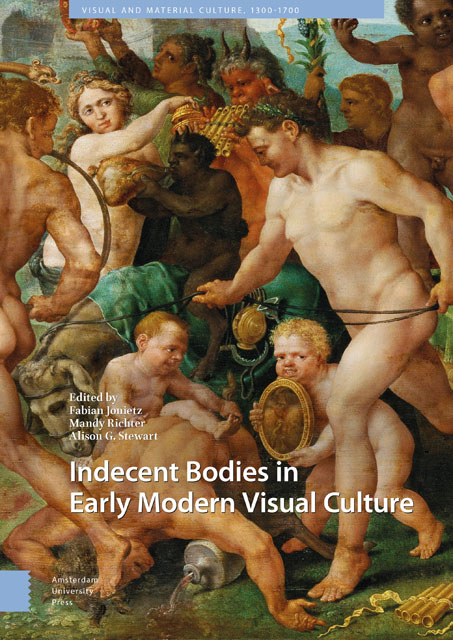Book contents
- Frontmatter
- Table of Contents
- List of Illustrations
- Indecent Bodies in Early Modern Visual Culture: An Introduction
- 1 Taste, Lust, and the Male Body: Sexual Representations in Early Sixteenth-Century Northern Europe
- 2 Private Viewings: The Frankfurt Context of Sebald Beham’s Die Nacht
- 3 To Show or Not to Show? Marcantonio Raimondi and the Representation of Female Pubic Hair
- 4 Treating Bodily Impurities: Skin, Art, and Medicine
- 5 Indecent Exposure and Honourable Uncovering in Renaissance Portraits of Women
- 6 Lust in Translation: Agency, Sexuality, and Gender Configuration in Pauwels Franck’s Allegories of Love
- 7 ‘So this guy walks into a forest…:’ obscenity, humour, sex, and the equine body in hans baldung’s Horses in a forest woodcuts (1534)
- 8 Indecent Creativity and the Tropes of Human Excreta
- 9 ‘It All Turns to Shit’ – The Land of Cockaigne in Sixteenth-Century German Woodcuts
- 10 Noëls and Bodily Fluids: The Business of Low-Country Ceremonial Fountains
- Index
7 - ‘So this guy walks into a forest…:’ obscenity,humour, sex, and the equine body in hans baldung’s Horses ina forest woodcuts (1534)
Published online by Cambridge University Press: 19 April 2023
- Frontmatter
- Table of Contents
- List of Illustrations
- Indecent Bodies in Early Modern Visual Culture: An Introduction
- 1 Taste, Lust, and the Male Body: Sexual Representations in Early Sixteenth-Century Northern Europe
- 2 Private Viewings: The Frankfurt Context of Sebald Beham’s Die Nacht
- 3 To Show or Not to Show? Marcantonio Raimondi and the Representation of Female Pubic Hair
- 4 Treating Bodily Impurities: Skin, Art, and Medicine
- 5 Indecent Exposure and Honourable Uncovering in Renaissance Portraits of Women
- 6 Lust in Translation: Agency, Sexuality, and Gender Configuration in Pauwels Franck’s Allegories of Love
- 7 ‘So this guy walks into a forest…:’ obscenity, humour, sex, and the equine body in hans baldung’s Horses in a forest woodcuts (1534)
- 8 Indecent Creativity and the Tropes of Human Excreta
- 9 ‘It All Turns to Shit’ – The Land of Cockaigne in Sixteenth-Century German Woodcuts
- 10 Noëls and Bodily Fluids: The Business of Low-Country Ceremonial Fountains
- Index
Summary
Abstract
Baldung's enigmatic woodcuts depicting horses in a forest (signedand dated 1534) have mostly been interpreted as sardonic yet seriouscommentaries on the making and limits of art, and as a scathing ifgeneral critique of human sexuality, in which the horses play a mostlysymbolic role. This essay, by contrast, considers the familiarphysicality of equine bodies as a key augmentation of obscene humourwittily engaged by the prints in their function to critique historicallyspecific sexual practices and gender roles.
Keywords: Hans Baldung; 1534 woodcuts; Early Modernhippology; Early Modern sexuality, Early Modern humour; Renaissancehorses
Taken together as a series, the three woodcut prints by Hans Baldung (c.1484‒1545), dated 1534 and depicting horses in a forest, have beennearly universally interpreted as a condemnation of unbridled humansexuality and the violence and chaos that follow in its wake. Thatinterpretation is surely, if partially, correct. The viewer of the prints isforced to bear uncomfortable witness to the stallion's powerful andshockingly explicit sexual arousal (fig. 7.1), to the explosion of maleorgasm robbed of procreative potential (fig. 7.2), and to the subsequentfrenetic brutality that results (fig. 7.3). Sexuality is depicted here asliterally bestial, uncontrollable, and dangerous. How mightsixteenth-century viewers have responded to these unusual and unsettlingimages? More precisely, and to address specifically the issues explored inthis volume, would the spectrum of their response have included finding theimages indecent?
My essay proposes that Baldung's prints would have been understood asobscene, and that they also would have provoked laughter. I suggest thatBaldung used obscene humour as a particularly effective strategy to critiquenot just human sexuality in general but normative sexual expressions andpractices as formulated in his own day. In addition to the concept andexercise of obscene humour in sexual imagery, Baldung's prints add afurther facet to the consideration of indecent bodies in this volume. In hiswoodcuts, the bodies in question belong to horses. Rather than assuming thatBaldung merely settled for equine bodies as an acceptable substitute for thehuman form, this essay posits that Baldung affirmatively chose horses toconvey his obscenely humorous response to sexual norms.
- Type
- Chapter
- Information
- Indecent Bodies in Early Modern Visual Culture , pp. 175 - 196Publisher: Amsterdam University PressPrint publication year: 2022
- 1
- Cited by



